

Dyno Results the new 8G Asian Civic 2.0S
I have just completed my test-drive loans for both the Civic 1.8S and 2.0S. Just as with the Civic 1.8S, I also had the Civic 2.0S checked out on the dyno when I had it on loan. And of course after looking at how the Civic 1.8S did on the dyno, here we take the next logical step and take a look at how the Civic 2.0S fared on the dyno.
The Civic 2.0S for Asia uses the 2.0l K20 DOHC i-VTEC engine. It is spec'ed for a max power of 155ps at 6,500rpm and a max torque of 19.2kgm at 4,500rpm, with a red-line of around 6,800rpm. This engine is set-up and tuned for daily driving and with an automatic gearbox, which means good power throughout the rpm-range, with special emphasis on low and mid-rpms which is where it spends most of its time in. For Malaysia and most of ASEAN, with the notable exception of the Philippines, the Civic 2.0S comes only with a 5AT variant though this time fitted with a manual sequential shifting option activated via paddle shifters on the steering wheel.
This Civic 2.0S had its work cut-out because it is the replacement for the successful 7th Gen ET1 Civic 2.0 i-VTEC, the car I personally credit for starting the revival of the Civic's reputation here in Asia. So how it performs on the dyno was of great interest to me, especially how it will stack up against the ET1. With the same rated max power of 155ps, I did not expect any surprises but in the end, I was nicely surprised by the results. The mileage on the unit when I took it for review was over 13,000km.
Dyno Check - Stock 8G Honda Civic 2.0S i-VTEC

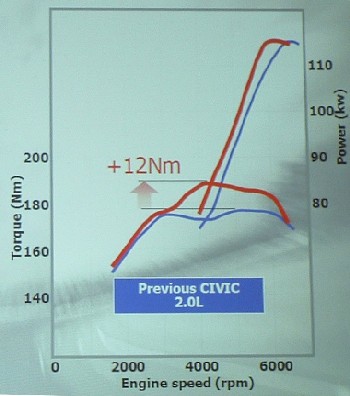
On the left is the dyno output for a completely stock Civic 2.0S DOHC i-VTEC with 5AT. As is the normal practise, the power/torque chart as published by Honda for the 'new' K20Z engine is shown on the right, in this case, as with the R18A engine, this is a combo chart with both the power and torque graphs for the K20Z and the replaced K20A from the ET1 Civic. As with the Civic 1.8S, again I will also highlight that the car being dyno'ed is a media review unit from Honda Malaysia so it has not gone through a proper run-in procedure. Actually it's the same unit that I drove at the media test-drive event during the launch so I am very sure this unit was quite stressed when its accumulated mileage was still way below 1,000km (actually if I remember correctly, it was not even above 100km at that time). Will this have any impact on the ability of the K20Z engine to deliver its best performance ? I will attempt to take a look at this perenial question later in this article. But for now, let us check out this unit as it is.
A stock Civic 2.0S DOHC i-VTEC 5AT delivers approximately 126ps at the wheels when measured on a Dynojet. In absolute terms, this result is extremely impressive indeed. From the paper spec of 155ps max power, 126ps at the wheels works out to over 81% which means that the new K20Z engine-5AT gearbox combo incurs less than 20% - only 19% power loss. This is even better than what the R18A managed to deliver and in comparison is not that much worse than what a manual gearbox will deliver ! So the days of power-robbing automatic gearboxes now seem to be dissapearing with the latest generations of Honda automatic gearboxes. Again, with more of the engine power that gets transfered to the front wheels, it means better performance from the car, subjected to other factors like the car's kerb weight and gear ratios of course. So the most significant thing about this result is that while on paper we get an engine with the same max power, in practise, and that's where it counts, its as if the engine is a more powerful one !
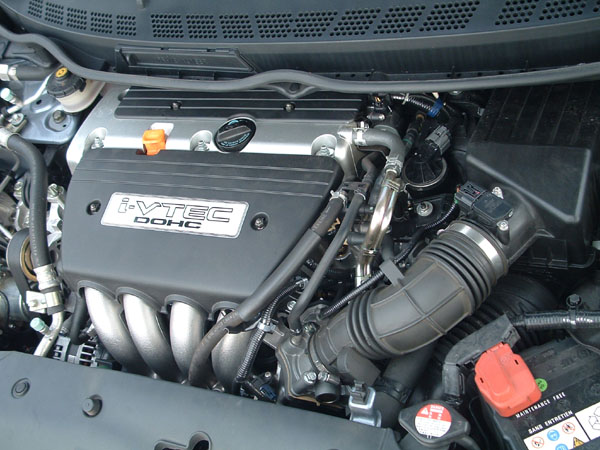
Unlike the case for the Civic 1.8S, for the Civic 2.0S, the dyno curves clearly deviate significantly from the published stock curves. Of special note would be the torque curve, where in their technical presentation of the engine Honda took great pains to highlight that they tune it to deliver an especially strong mid-range. The max torque point for the K20Z is given as 4,500rpm and in the stock chart, we can see how Honda wanted to 'fill-up' the 'hole' that the original ET1 Civic's K20A had in its torque curve. Well, that was on paper. On the dyno however, this result does not seem to be delivered. The torque curve for the 'new' K20Z engine clearly still has that 'hole' in its torque curve. So while the paper specs say max torque is at 4,500rpm, the dyno shows it to be at 6,000rpm, with a 'hole' in the 4,000 to 6,000rpm region. From a torque of around 15kgm, the curve starts to dip after around 4,250rpm and drops by almost 1kgm at 5,000rpm after which it starts to increase again. The torque and power delivery also seems quite rough in this region. The max power point is quite near the paper spec though, at around 6,300 to 6,400rpm. After seeing the result from the R18A, this result from the K20Z seems quite unusual - and slightly dissapointing - especially after the nice surprise seeing how much max power the engine delivers on the dyno.
With the air-fuel ratio, the K20Z departs from other modern Honda engines that I have seen dynos of. The K20Z runs at the 'optimum' air-fuel ratio (for power delivery) of 13:1 for most part of its rev-range, right until approximately 5,750rpm. Immediately after that, the engine starts to go rich, and the air-fuel ratio drops like a brick right down to below 12:1 and stays consistently there until the redline of 6,800rpm. Actually the change in air-fuel ratio seems to correlate quite well with the 6,000rpm point after which the torque and power curves becomes smooth again. In theory however, the engine should deliver its best power at 13:1 A/F ratio, based on experience with past Honda engines especially the great B-series.
Personally I have two conjectures about the midrange of the K20Z. One is the air-fuel ratio. The change in A/F from 13:1 to <12:1 coincides too well with the 'recovery' of the torque/power delivery, from a rough midrange with a 'hole' in the middle, to smooth power delivery and matching that of the published stock graph after around 6,000rpm. While experience with 'older' Honda engines like the B and H-series showed that and A/F of 13:1 is the best for power delivery, there is a possibility the the consistently rich running condition of modern Honda engines like this K-series and the L-series as well could be due to design rather than a safety factor. Meaning, could it be that the modern Honda K-series and L-series engines produces their best power when running at a rich 12:1 A/F ratio ? Would it be possible that the rough midrange of the K20Z is due to it running relatively 'lean' (compared to 12:1) in the 4,000-6,000rpm mid-band ?
My other conjecture regarding the 'hole in the midrange' of the K20Z is with regards to ignition timing. The K20Z is DOHC i-VTEC of course so it features VTC. Actually the rough portions of the torque/power curves reminds me of cases where the engine is running with out-of-tune ignition timing so I wonder if this case might be due to bad settings with the stock VTC mapping.
Despite the notes about the mid-range of the engine, the overall result from the K20Z's dyno session is still a very good one. As noted above, 126ps at the wheels from a rated 155ps for the engine is a very good result indeed, for an engine mated to an automatic gearbox. As the Civic 2.0S comes with the sequential shifting option, in use, this makes the car very preppy and nice to drive - the hole in the midrange is not noticeable at all - and the engine happily revs all the way to the red-line without any signs of strain or hesitation.
K20Z vs R18A
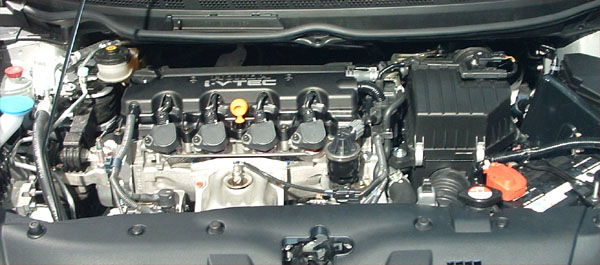
In my article on how the Civic 1.8S delivers on the dyno, I have compared the R18A's dyno result against the old K20A from the ET1 Civic 2.0 i-VTEC and with interesting results. On the dyno, the R18A showed exactly the 'fat midrange' that Honda designed it to deliver, with the result that it actually deliver more torque/power than the old K20A at some points in the rev range ! Of course that was against the 'old' K20A so the more pertinent question for R18 vs K20 is more like how the R18A compares against this 'new' K20Z. Of course at that time I have not published the dyno-result for the new K20Z so I did not do this comparison. But now in this article I will compare the dyno results between the R18A and the 'new' K20Z engine.

The side-by-side comparison chart is again shown on the left. Two things are apparent. One is how much more torque and power the K20Z has over the R18A. This should settle any and all debates about whether the R18A can outperform the K20Z or not. It most definitely does not and in fact is outperformed by the K20Z all across the rev-range. The other thing is how the R18A succcessfully delivers the 'fat midrange' torque/power it is designed to while the K20Z clearly fails in delivering that. Now remember while the i-VTEC for both R18A and K20Z stands for 'intelligent', in reality the R18A does NOT feature VTC while the K20Z does. So this do lend some support for my conjecture that perhaps the cause for the K20Z's failure to deliver its design objective with regards to mid-range torque and power could be that the VTC mapping is out of tune for ASEAN conditions.
The other thing to note would be how (relatively) close the R18A manages to stay with the K20Z for torque/power in the low-end/mid-range rpm range but that after 5,500rpm, how the K20Z quickly out-delivers it. This of course shows how much superior VTEC is for high-rpm power delivery, against alternate technologies like variable intake tracts like that used on the R18A. Remember that while the R18A also use VTEC, it is used to switch an economy cam profile while the basic cam profiles are actually the 'high-cams'. So high-cams on the R18A which are active for normal operations on the R18A, will need to be compromised for good torque/power delivery at WOT across the whole rpm range since it is used throughout. This is in contract to i-VTEC on the K20Z which has two separate cam lobes for low/mid and high-rpms and so can go much further in terms of aggressive valve timing for the 'hi-cams'.
K20 vs K20 - New versus Old

It is now time to compare the old K20A and new K20Z engines in terms of how they fare on the dyno. The side-by-side comparison chart is again on the left. For this comparison, instead of the result for the red ET1 Honda Malaysia review unit that I published in my ET1 Civic 2.0 i-VTEC full review, I am using the result for a completely stock unit that belongs to one of AMOIL's customers. I take this because I feel it is more representative of what an actual unit on the road wil deliver, one that has gone through a proper run-in procedure and driven 'normally' by an actual owner. This validity of this choice will be apparent in the next section.
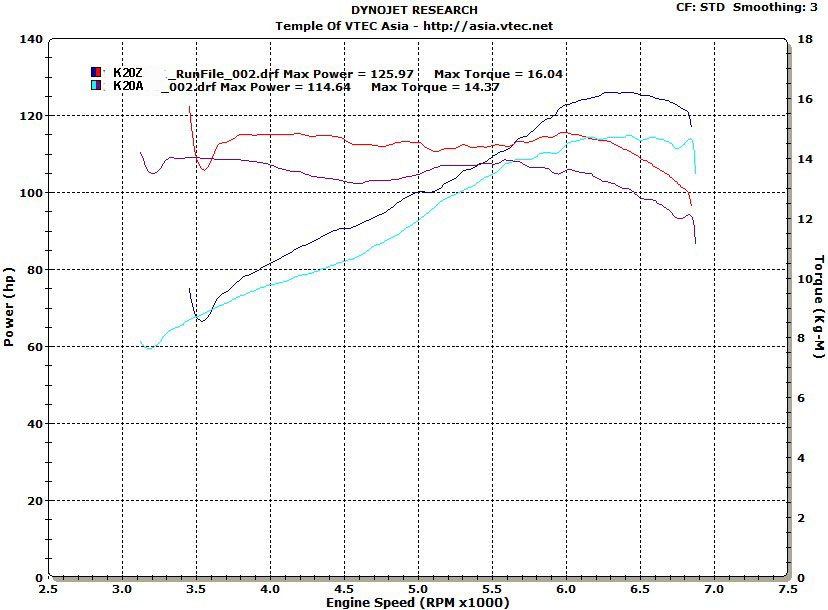
How does the 'new' K20Z compare against the 'old' K20A ? Now, remember that on a dyno-check, we are not actually seeing the 'performance' of the engine in isolation but really the engine-gearbox combo. In this case, the customer ET1 Civic 2.0 i-VTEC delivered around 115ps on the dyno as compared to 126ps for the Honda Malaysia unit. This is a massive (relatively) 11ps difference ! Put this in another perspective. While many enthusiasts are lamenting how the max power for the 'new' 8G Civic 2.0S remains the same 155ps as the 'old' 7G Civic 2.0 i-VTEC, on the dyno and on the road, where it counts most, the new 8G Civic 2.0S is actually delivering power as if it has an engine rated at almost 170ps (at the engine) instead ! Because that's what 126ps would have worked out to if we had use the power loss ratio that the old K20A engine-gearbox combo had incurred. So while on paper, the new 8G Civic 2.0S and the old 7G Civic 2.0 i-VTEC are equally as powerful, on the dyno and on the road, the new 8G Civic 2.0S is in reality a lot more powerful - and faster ! Of course the heavier kerb weight of the new model will dull the power advantage a bit but this will be compensated for by the flexibility offered by the sequential shifting option.
And so its probably a bit of bad news to owners of the 'old' ET1 Civic 2.0 i-VTEC while a bit of good news to owners and potential owners of the 'new' Civic 2.0S but the fact is that the new model is most definitely faster than the old one in straight-line speed.
Apparent from the comparison chart would be the 'hole in the middle' of the torque/power curves for both old and new K20 engines. In this case, the hole is more pronounced in the old K20A as compared to the new K20Z but the fact remains that the K20Z still has that power dip in the midrange. The bad news is that there is as yet no simple way to re-tune the VTC on the current generation of Honda's DOHC i-VTEC engines unless we replace the stock ECU maps altogether. The only company capable of doing that are people like Spoon, Mugen and of course Hondata. I know Hondata does not offer options for the Asian K20Z but since this variant is also sold in the JDM, hopefully Spoon or Mugen or some other japanese aftermarket companies might offer a solution in the near future.
Counter-Point : Dyno Result for another stock Civic 2.0S

It is EXTREMELY important that we run in a brand new Honda engine PROPERLY. This statement/advice has been often given by us enthusiasts to any and all owners of a new Honda car, in fact anyone who is willing to listen. While there have been some debates about how applicable this advice is, I for one am totally confident about its validity and I personally stand by this advice. How can I be so sure ? This really comes from having seen and experienced so many different Honda cars. Especially relevant was the unique opportunity to compare two identical units of Honda Jazz VTECs at the same time. This was when I was doing the performance test for the Jazz VTEC. One unit was the Honda Malaysia review unit with over 10,000km mileage while the other was my own personal car which at that time had barely 4,000km on the odometer. The difference in the performance of the engine in particular, how free-revving it was, its power delivery, the fuel economy, and so forth, all the different parameters were very different between the 2 units. Then when I had a chance to put on the miles on my unit, the tables were turned because I adopted a careful run-in procedure for my unit while the Honda Malaysia unit was literally thrashed even when its accumulated mileage was barely over 100km only. So after being runned in properly, my personal car felt a lot better than the Honda Malaysia unit. But some have argued that all my observations were just that, personal subjective observations only. How accurate can they be ? How much of it might well be simply just in the mind ? In this article, I look at 1 case study in support of my run-in 'policy'.
While the result for the Honda Malaysia review unit was very impressive, AMOIL have also recently dyno'ed another unit of the Civic 2.0S which they assured me was completely stock. In fact, I was told that the car just came back from its service at the time the owner brought it in for its dyno check. While both that car and the Honda review unit are completely stock, the main difference would be how the car was used during the 1,000km run-in period. The owner of the other car followed the recommended run-in procedure, of not stressing the engine and limiting revs during that period. Meanwhile, the Honda review unit was pretty much pushed to its limit when we tested it at the media test-drive event that was held in conjunction with its launch, at the time when accumulated mileage wasn't even at 100km yet. So here we have 1 car which has been carefully run-in and another which was definitely not properly run-in. Is there a difference, especially in how well the engine performs ? While I might be accused of imagining any subjective differences with the Jazz VTECs, here I am looking at hard physical data - how much power does both the engines deliver on the dyno. Remember, the dyno doesn't lie and furthermore both cars were checked on the same dyno at the same location.
The side-by-side comparison chart is on the left. If the Honda review unit was impressive at delivering 126ps at the wheels on the Dynojet, the customer unit was even more impressive because it delivered 132.5ps at the wheels ! This is an extra 6.5ps or 5% more power ! Put another way, the significance of this difference is that it's as if the customer unit is rated at 163ps at the engine instead of 155ps ! Indeed if we had compared this unit to the ET1 instead, then the nett result would be as if its engine is rated at 179ps, almost 180ps !!! I cannot begin to emphasize how impressive a result of 132.5ps at the wheels is for this unit. For a final perspective, 132.5ps at the wheels when matched to 155ps at the engine works out to a power-loss of slightly less than 15% ! This is even better than what Honda's 5MT, i.e. manual gearboxes used to incur on the great Civics like the EGs and EKs ! So if this result is repeatable, then it simply means that in terms of power-loss, the new generation of Honda's 5AT are equally as efficient as the manual gearbox ! But of course enthusiasts want a manual gearbox for other reasons as well, especially the joy of the manual gearshift.
Equally as impressive is how the superior power was delivered consistently across the rev-range. Both the graphs are the same profile, only the one for the customer unit is placed quite a bit higher on the chart than the one for the Honda review unit. Now remember, both units are completely stock, so engine wise they are completely identical. One possible cause for the difference seen in the dyno chart above can be accounted for if the owner had changed his rims to super-lightweight magnesium alloys. While I can't confirm if this is the case, it is highly unlikely for a Civic owner. Furthermore, different wheels will not be able to account for such a large power difference. The only other possibility that will account for this power difference would be how the engine was used during the run-in period. In this case, while it may not account for all the power difference, it is quite clear that it is responsible for at least part of it. So while some may continue to argue about its validity, I think this case study puts forward a very strong arguement for the importance of properly running-in our brand new car ! Of course this comparison is only between 2 units. Hopefully in the future I will be able to check out the dyno results for more stock units of Civic 2.0S to verify the consistency of this result but now more than ever, I am fully convinced about the validity of the advice - of how important it is that we run-in our brand new Honda properly.
Conclusion
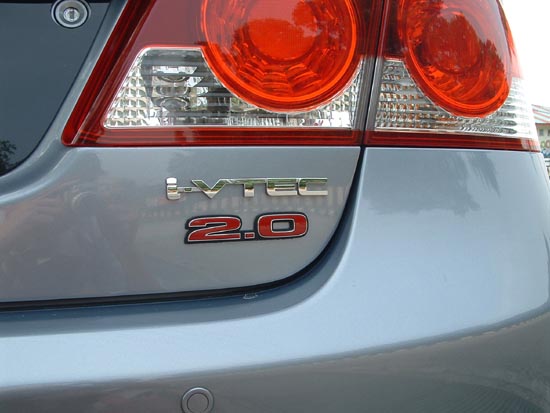
The results of the dyno-checking the new 8G Civic 2.0S is a little bit of a mixed bag for me. The most important thing is of course how well the Civic 2.0S performs on the dyno in terms of power delivery. But power delivery too is where it also dissapoints as the dyno result does NOT show the 'fat midrange' that the Honda R&D engineers emphasized so strongly. More significantly is that the R18A succeeds in delivering this fat-midrange on the dyno while the K20Z does not. Again, I have explained my suspicions that bad VTC mapping could be the cause for this short-fall and let's hope that we might see simple but effective means of correcting this in the near future.
Nevertheless, after having written all the above, in the end I am extremely impressed by the 'new' K20Z engine, especially the one in AMOIL's customer unit. If that result can be consistently delivered, then this new Civic 2.0S is one fast car. And the Honda Malaysia review unit, despite the lower power, is already a pretty fast car. While I will continue to hope for the Civic 2.0 Si sedan to come to Asia, in the meantime, especially for those who do not put outright performance at a premium but rather desires a well balanced, comfortable but respectably fast car, this new 8G Civic 2.0S delivers the goods very well on the dyno. And in my test drive as well. But that is of course is for another article to write.
Wong KN
November 2006
© Temple of VTEC Asia and Temple of VTEC